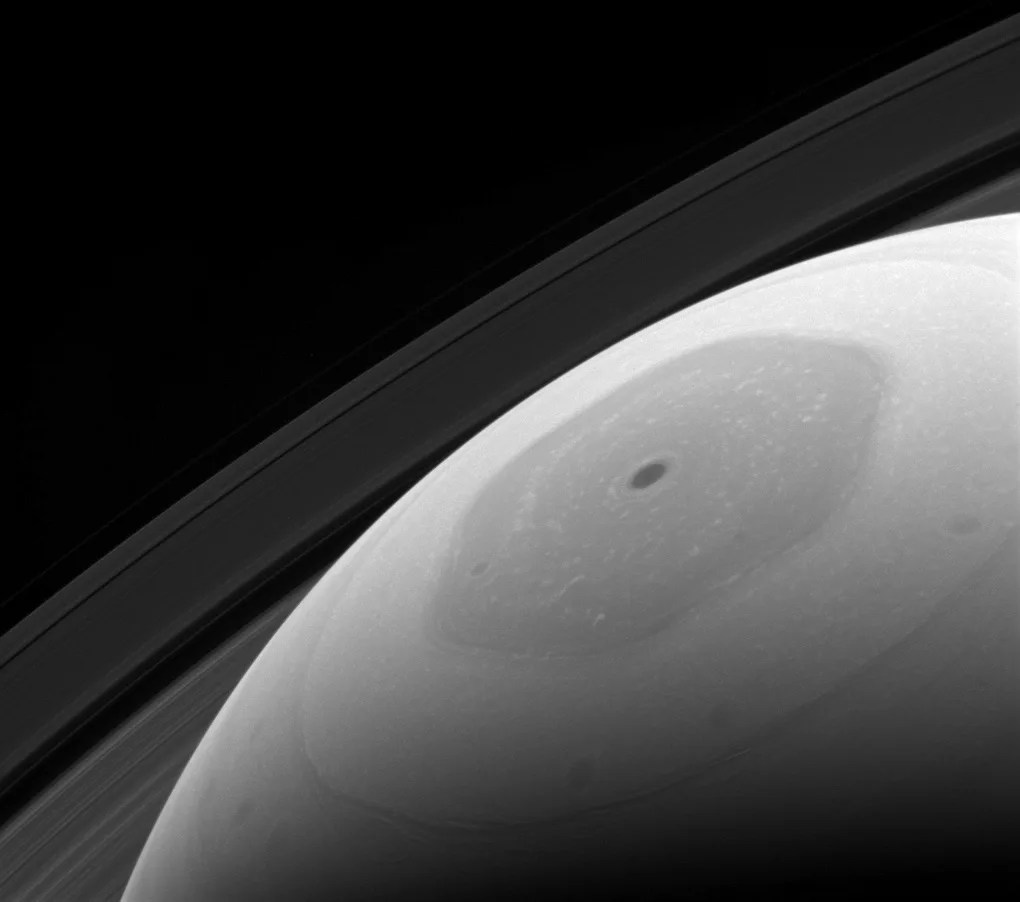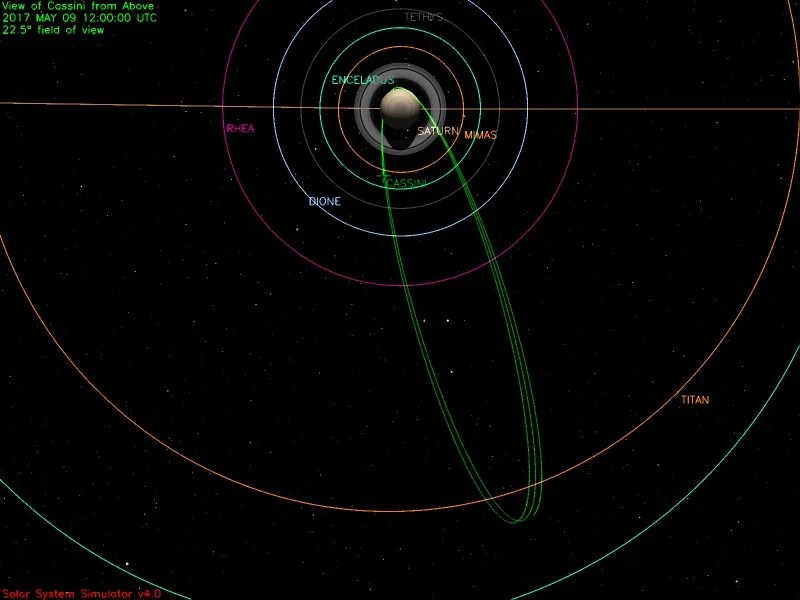7 min read

The highly capable flight system known as Cassini has been proving its scientific value in this new mission assignment, the proximal orbits of the Grand Finale. Meanwhile the ground system that forms its other half, literally thousands of tons of concrete and steel in the Deep Space Network (DSN) worldwide, has been proving its exquisite sensitivity and extraordinary capability as well. The closest-ever measurement of Saturn's gravitational field, which is an important objective in this virtually new mission, was one of several science highlights this week. To accomplish this, Cassini's Radio Science team brought out the best of both the flight and ground systems at the same time, as they often do.
Wednesday, May 3 (DOY 123)
Cassini started the day going 55,367 kilometers per hour relative to Saturn, climbing away from its skin-close periapsis passage the day before. By the end of the day, it had slowed to 18,600 km/h on its way to apoapsis passage on Saturday morning.
The Radio and Plasma Wave Science (RPWS) team analyzed the near-Saturn dust environment following the first proximal ring plane crossing on April 26, concluding that the dust level in the proximal region is much lower than anticipated. This eliminated the need for Cassini to use its high-gain antenna as a shield during most of the future close-in dives through the ring plane. This is good news because all of the planned science observations during the remaining orbits will be unaffected.
First off today, Cassini's Imaging Science Subsystem (ISS) took advantage of the final opportunity to observe Saturn's rings at extremely high-phase lighting angles, while the Sun was hidden behind the huge planet. During seven hours of observations, ISS surveyed the faint ringlets within the main rings, many of which are difficult to observe outside of this geometry. Some of the observations will be stitched into a movie of the innermost D ring, to monitor its various structures. Riding along to make their own observations were the Visible and Infrared Mapping Spectrometer (VIMS) and the Ultraviolet Imaging Spectrograph (UVIS).
ISS then turned to examine Saturn's irregular moon Bebhionn for 4.2 hours. This little object, about six km in diameter, orbits Saturn in an inclined ellipse that reaches as far as 25.1 million km from the planet. It might have a binary or contact-binary nature. Bebhionn was named after a goddess in early Irish mythology.
Following this, the Composite Infrared Spectrometer (CIRS) began an 11.5-hour study of the composition and structure of Saturn's C ring, with VIMS and UVIS riding along. The viewing geometry that the Optical Remote-Sensing (ORS) instruments were experiencing at this point, that of the Saturn-system's unlit side, is illustrated here.
All the while today, the Magnetospheric and Plasma Science Instruments (MAPS) were taking full advantage of their opportunities to directly sense the environment. They continued to do so throughout the week.
One of the results of Cassini's first proximal-orbit dive past the planet was this series of close-up images of Saturn: /news/13035/new-movie-shows-cassinis-first-dive-over-saturn .
Thursday, May 4 (DOY 124)
Late in the day, ISS began 13.4 hours of observing Saturn's faint, dusty rings at high phase angles (sunlit from behind) and low ring opening angles. This geometry is useful for observing very faint E ring and G ring, and is particularly good for monitoring the structure of these rings, which have been observed to change over the course of the Cassini Mission.
Friday, May 5 (DOY 125)
The Cassini Project Scientist and Project Manager presented a talk entitled: “Going out in a Blaze of Glory: Cassini Science Highlights and Grand Finale” at JPL as part of the Von Kármán lecture series on May 4, and at Pasadena City College today.
Saturday, May 6 (DOY 126)
When Cassini reached the top of its apoapsis "hill" today, it had climbed out to 1.27 million km from Saturn, and had slowed to 6,033 km/hr relative to the planet. This marked the start of Orbit #273. Here's an illustration of the view from way "up" there, in which the background star pattern may be familiar to sky watchers.
CIRS turned its gaze "down" toward the sunlit side of Saturn's broad A ring. With UVIS and VIMS riding along, it made observations for six hours that should constrain estimates of some parts of the ring's emissivity at thermal-infrared wavelengths.
Next, UVIS took control of the spacecraft's pointing for 4.8 hours to make slews across Saturn's northern auroral region, capturing the planet's night side auroral dynamics for nearly half a planetary rotation.
Sunday, May 7 (DOY 127)
ISS called the shots for 14 hours to observe the atmosphere of Saturn's largest moon Titan. CIRS and VIMS rode along. Next, CIRS took the reins, with ISS riding, as the distance to their target Titan shrank to 496,000 km. ISS then took control for another 9.7 hours, still on Titan, with CIRS and VIMS still riding along.
Monday, May 8 (DOY 128)
ISS finished up its series of Titan observations with a high-priority, low-phase-angle (almost fully sunlit) view of the planet-like moon lasting one hour, with CIRS and VIMS riding.
A beautiful view of Saturn's strange hexagon was today's featured image: /resources/17672 .
Tuesday, May 9 (DOY 129)
Today Cassini sped by Saturn again, for the third time, close to the atmosphere and interior to the ring system. Periapsis came 6.2 hours into the day, when the spacecraft's planet-relative speed had soared to an astounding 122,498 km/hr.
For a brief time Cassini passed in front of the planet as viewed from Earth, and that view was across an expanse of rings. All during this close passage to Saturn, Cassini kept its high-gain radio antenna trained on Earth, and the Radio Science team used Cassini's three-frequency downlink to measure Saturn's gravity field, and to observe a ring occultation that probed the ring structures' physical properties. This experiment used Earth-based tracking stations on four continents, for a total of 24 hours, capturing and recording unique high-resolution measurements of Cassini's continuous radio signals, received both directly, and after being scattered by ring material at very close range.
One objective of the gravity field measurement, for today's and subsequent experiments, is to disentangle the strong acceleration due to Saturn’s oblateness from that due to the tiny pull of the rings. Another objective is to measure the density distributions inside Saturn, including the mass of the planet's core.
All during this close approach to Saturn, the MAPS instruments continued sampling the environment. In particular, the Magnetometer (MAG) made unique observations of Saturn’s internal magnetic field.
Following the Radio Science activity, the ISS Titan cloud monitoring campaign resumed for two hours, with VIMS and CIRS riding along. Near the day's end, VIMS spent one hour observing the bright red star Alpha Orionis (Betelgeuse) as it entered occultation behind Saturn's atmosphere.
Some of the results of Cassini's Titan monitoring are featured in this image: /resources/17673 .
The DSN communicated with and tracked Cassini on 14 occasions this week, using stations in California, Spain, and Australia; the European Space Agency supported once using their station in Argentina. A total of 30 individual commands were uplinked, and about 1,692 megabytes of science and engineering telemetry data were downlinked and captured at rates as high as 124,426 bits per second.
Wrap up:
Cassini has finished the first three of its 22 Grand Finale Proximal orbits, which have a period of 6.4 days, in a plane inclined 62.4 degrees from the planet's equatorial plane.
The most recent spacecraft tracking and telemetry data were obtained on May 10 using the 70-meter diameter DSN station in Australia. The spacecraft continues to be in an excellent state of health with all of its subsystems operating normally except for the instrument issues described at http://saturn.jpl.nasa.gov/anomalies .
The countdown clock in Mission Control shows 129 days until the end of the Mission.
This illustration shows Cassini's path up to mid-day May 9, when the spacecraft was speeding outbound from its most recent very close encounter with Saturn.








